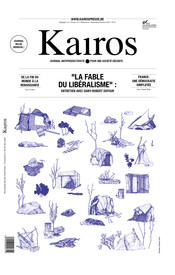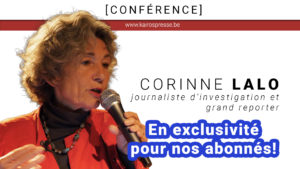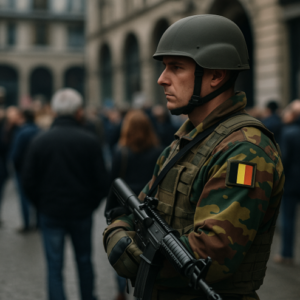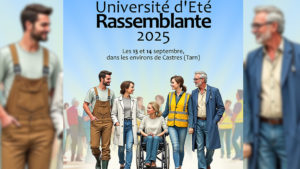RÉCIT D’UNE LUTTE DANS LES BASSINS DU RHIN POUR LA JUSTICE CLIMATIQUE
Le sommeil est léger, la chaleur, le bruit ne venant pas à bout de ces questions du sens de ce que l’on fait, de nos choix face à la finitude, de nos vies, de nos luttes… Qu’est-ce que je fais ici ? J’ai une trentaine d’années et pour la première fois je me retrouve impliqué dans une action massive de désobéissance civile pour la justice climatique et contre l’exploitation du charbon.
Ende Gelande. Depuis plusieurs années, cet ensemble de collectifs, associations, ONG et autres groupes politiques organise des mobilisations dans différentes régions d’Allemagne touchées par les exploitations de lignite(1). Leur but est de sensibiliser un public plus large à la nécessité d’un changement rapide et radical de modèle sociétal. Pollution de l’air, perte de biodiversité, réchauffement global, destruction de forêts anciennes, expropriation de villages entiers… le bilan de ces activités n’annonce rien de bon pour les années à venir. La cible principale était cette fois-ci le site de Garzweiler, pas bien loin de Cologne, une plaie béante de 48 km², destinée à devenir un lac d’agrément d’une superficie de 2.300 hectares à la fin de son exploitation, en 2045. Forcément, un beau plan d’eau ça fait plus propre et, comble du greenwashing, cela pourrait même devenir une zone Natura 2000.
Au réveil, la mine (la mienne) est affreuse, mais le moral tient le coup. Il faut dire que la journée précédente avait sonné comme un échec. On était environ 350 individus à quitter le camp principal, le sac plein de vivres et d’affaires, bien décidés à occuper le site d’excavation le plus longtemps possible. Mais la police, mobilisée en masse pour l’événement (on parle de plus d’un millier d’agents déployés) est bien décidée à nous barrer la route. Néanmoins, aujourd’hui est un autre jour. Nous passons la matinée à voir affluer des gens de partout, venus en trains, en bus, en voitures ou encore à vélo. Le cortège commence enfin à se rassembler, nous sommes au moins 1.500, tous vêtus de la combinaison blanche et du sac de paille, notre seul moyen de nous défendre face aux matraques de la police.
Quelques centaines de mètres à peine et voilà déjà un premier barrage de police sur notre chemin. Á la différence de la journée précédente, la décision est prise de ne pas éviter la confrontation. Tout va très vite. Toujours est-il qu’une brèche se crée sur la droite de la ligne d’agents, la masse de personnes en mouvement aidant. Cela suffit à ce que des activistes s’y incrustent, que les policiers soient déstabilisés et que la colonne entière passe le barrage. Et de un.
Les cortèges s’élancent alors d’un bon pas à travers les champs vers les rails qui alimentent l’une des centrales électriques en lignite. Au loin se dessine la ligne de chemin de fer, surélevée par rapport aux champs, devant elle, une ultime rangée de camionnettes occupant tout l’horizon nous attend. Nous la dépassons sans peine grâce à la diversion du groupe de tête. Soudainement, quelqu’un lance un signal de dispersion. Le cortège s’éclate en binômes qui profitent de la moindre faille dans la ligne de police pour s’élancer à l’assaut de la butte donnant sur le chemin de fer. Malgré leurs trop nombreux coups de matraques ou de pieds, les agents n’empêcheront pas un seul membre de notre cortège d’atteindre les rails.
Á peine arrivés sur les rails, la police commence déjà à nous encercler. Ils nous somment de quitter les lieux par leurs haut-parleurs, mais nous chantons bien trop fort pour les entendre. Nous nous regroupons, nous nous asseyons au milieu du chemin de fer et déposons nos sacs à dos. Suite au succès de notre action et à l’afflux d’adrénaline des dernières heures, l’émotion est au rendez-vous. De part et d’autre des rails, on aperçoit au loin d’autres groupes qui s’installent. Nous ne sommes définitivement pas seuls. Après plusieurs heures de marche à vive allure et de coups de policiers, l’occasion se présente pour un peu de repos, manger un bout, se désaltérer. Le temps passe. Ça discute, ça chante, ça danse. Certains d’entre nous tentent même une blague à l’attention de la police. Devant ce spectacle la police reste la plupart du temps stoïque. De temps en temps des signes d’humanité. Un sourire s’échappe ici et là de leur armure moderne.
Plusieurs heures passent dans cette étrange ambiance, jusqu’à ce que la police fasse venir des wagons entiers pour nous déplacer. Les uns après les autres nous nous faisons arrêter, de manière musclée si nous n’acceptons pas de notre plein gré (sic) : coups, tirages de cheveux et autres clés de bras. On nous monte dans les wagons comme du bétail. Quelques kilomètres plus loin, des agents nous descendent. Un espace entièrement entouré de fourgons de police nous y attend, avec son lot d’hommes et femmes armés. On nous y parque quelques heures avant de nous déplacer dans des bus blindés à cellules jusqu’au commissariat régional. Un agent nous annonce qu’à moins que nous désirions donner notre identité et nos empreintes, seule une photo sera prise avant de nous relâcher. Dehors, nourriture et musique nous attendent pour célébrer la victoire très symbolique de l’action.
QUE PEUT-ON EN TIRER ?
Avec du recul, les résultats de notre mobilisation peuvent sembler dérisoires, nous n’avons ni révolutionné le système énergétique contemporain, ni mis à mal le mode de production capitaliste. Je pense toutefois que l’intérêt se trouve ailleurs, dans la médiatisation du discours de justice climatique d’Ende Gelande au travers de ces actions. Mais surtout, ces mobilisations rappellent aux autres et à soi-même que la désobéissance civile non-violente peut mettre des bâtons dans les roues des multinationales. Ces compagnies géantes sont devenues tellement abstraites à nos yeux qu’on en oublie qu’elles s’inscrivent dans la matière, dans la logistique, dans des infrastructures. « Nous sommes ensemble et nous sommes capables » : voilà comment je conçois le message d’Ende Gelande. Quand on voit l’ampleur, l’horizontalité et l’autonomie de l’organisation d’Ende Gelande, on est en droit d’être relativement confiant quant à la capacité des êtres humains à créer des formes de sociétés démocratiques, écologiques, féministes, non-capitalistes et anti-racistes.
À la fin de ce week-end, le prochain grand rendez-vous est fixé début novembre, juste avant le début de la COP23 qui se déroulera à Bonn. Une bonne occasion de dénoncer l’inefficacité du processus des Nations unies et de crier haut et fort la nécessité d’une action désobéissante de masse afin de nous protéger, nous et les générations futures, de leurs modes de production néfastes. Si nous ne les arrêtons pas, qui le fera ? Que chacun d’entre vous, chers lecteurs, se sache bienvenu pour nous rejoindre. Nous vous donnons rendez-vous en novembre.
Alexandre Orban
*Lien vers les photos des mobilisations: https://www.flickr.com/photos/133937251@N05/albums
Plus d’informations sont disponibles via
- le site officiel d’Ende Gelande : www.ende-gelaende.org ;
- des organisations participantes, telles que Friends of the Earth, 350.org ou encore plus localement le réseau ADES, la JOC
- l’auteur de cet article, Alexandre Orban ( alxorban@gmail.com )
- Type de charbon utilisé comme combustible dans les centrales électriques. L’Allemagne est le premier producteur mondial de lignite. En 2016, l’Allemagne produisait 40 % de son électricité grâce au charbon. On dénombrerait plus de 3.600 morts prématurés annuels dans le pays liés à la pollution aérienne imputable à la combustion du charbon (www.lemonde.fr).







